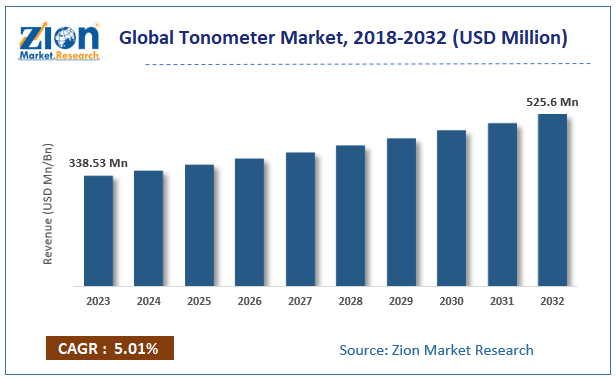Tonometer Market Size, Share, Trends, Insights and Forecast, 2032
The tonometer market focuses on devices used to measure intraocular pressure (IOP), which is a critical parameter in the diagnosis and management of glaucoma and other eye conditions. Tonometers are essential tools in ophthalmology and optometry, providing valuable information for assessing eye health and preventing vision loss associated with elevated intraocular pressure.

Get a Free Sample : https://www.zionmarketresearch.com/sample/tonometer-market
Key Market Insights
Market Growth Drivers:
- Increasing Prevalence of Glaucoma: The rising incidence of glaucoma, particularly in aging populations, is a major driver for the tonometer market. Early detection and monitoring of intraocular pressure are crucial for managing this condition.
- Advancements in Tonometer Technology: Innovations in tonometry, such as non-contact and portable tonometers, are enhancing accuracy, ease of use, and patient comfort, driving market growth.
- Growing Aging Population: As the global population ages, the demand for eye care and regular monitoring of intraocular pressure increases, boosting the tonometer market.
- Awareness and Screening Programs: Increased awareness about eye health and routine screening programs for glaucoma contribute to the growing demand for tonometers.
- Expansion of Healthcare Infrastructure: Investments in healthcare infrastructure and increasing access to ophthalmic care in emerging markets are driving the adoption of tonometers.
Market Segmentation:
By Type:
- Goldmann Applanation Tonometers: Considered the gold standard for measuring intraocular pressure, typically used in clinical settings for accurate IOP measurements.
- Non-Contact Tonometers (NCTs): Use a puff of air to measure IOP without touching the eye, offering a more comfortable and less invasive option for patients.
- Portable Tonometers: Handheld devices designed for ease of use in various settings, including field screenings and remote locations.
- Rebound Tonometers: Measure IOP by assessing the rebound of a small probe that briefly contacts the cornea, providing quick and convenient measurements.
- Other Types: Includes tonometers based on various other technologies and specialized applications.
By Application:
- Glaucoma Diagnosis and Management: Primary use of tonometers to detect, diagnose, and monitor glaucoma by measuring intraocular pressure.
- Routine Eye Examinations: Used in regular eye exams to assess eye health and detect potential issues related to intraocular pressure.
- Post-Surgical Monitoring: Employed to monitor IOP after ocular surgeries, such as cataract surgery or laser procedures.
- Research and Clinical Trials: Used in research settings to study and develop new treatments and technologies for eye care.
By End-User:
- Hospitals: Major users of tonometers for comprehensive eye care and management of ocular conditions.
- Ophthalmology Clinics: Specialized clinics focusing on eye health, where tonometers are essential for diagnosing and treating eye conditions.
- Optometry Offices: Include tonometers as part of routine eye exams and patient screenings.
- Home Care: Growing interest in home monitoring devices for patients requiring regular IOP measurements.
- Research and Academic Institutions: Use tonometers for research purposes and the development of new eye care technologies.
Geographical Insights:
- North America: The largest market, driven by advanced healthcare infrastructure, high adoption of new technologies, and strong awareness of eye health.
- Europe: Significant growth due to high standards of ophthalmic care, increasing aging population, and supportive healthcare systems.
- Asia-Pacific: Expected to see rapid growth due to rising healthcare investments, increasing prevalence of eye conditions, and expanding access to eye care services.
- Latin America and Middle East & Africa: Emerging markets with growing healthcare infrastructure and increasing focus on improving eye care services.
Challenges:
- High Cost of Advanced Devices: The cost of sophisticated tonometers can be a barrier, particularly in cost-sensitive regions and smaller practices.
- Technical Expertise Required: Proper use and interpretation of tonometry results require specialized training and expertise, which can limit accessibility in certain settings.
- Maintenance and Calibration: Regular maintenance and calibration of tonometers are necessary to ensure accuracy, which can be challenging for some healthcare providers.
- Market Fragmentation: The presence of various types of tonometers and technologies can lead to market fragmentation and difficulty in standardizing practices.
Competitive Landscape:
- Key Players: Major companies in the tonometer market include Haag-Streit, Reichert Technologies, Nidek Co., Ltd., Canon Medical Systems, and Tomey Corporation. These companies focus on technological innovation, product development, and expanding their market presence.
- Product Innovation: Companies are investing in developing new tonometers with enhanced features, such as improved accuracy, portability, and user-friendly interfaces.
Future Trends
- Integration with Digital Health: The incorporation of digital health technologies, such as data analytics and remote monitoring, with tonometers is expected to enhance patient management and streamline workflows.
- Advancements in Non-Contact Tonometers: Continued innovation in non-contact tonometry will likely lead to more accurate, comfortable, and user-friendly devices.
- Growth of Portable and Home Monitoring Devices: The development of portable and home-use tonometers will cater to patients needing frequent monitoring and enable better management of chronic conditions.
- Focus on Early Detection and Preventive Care: Increasing emphasis on early detection and preventive care will drive demand for advanced tonometry solutions and routine screening programs.
- Expansion in Emerging Markets: Growing healthcare infrastructure and increased access to eye care services in emerging markets will drive the adoption of tonometers in these regions.
The tonometer market is set for growth as advancements in technology, increasing demand for early detection of eye conditions, and expanding healthcare infrastructure drive the adoption of these devices. The future will likely see greater integration with digital health tools, continued innovation in non-contact and portable devices, and increased availability in diverse clinical settings.
Contact :
US OFFICE NO +1 (302) 444-0166
US/CAN TOLL FREE +1 (855) 465-4651
Email: sales@zionmarketresearch.com

Comments
Post a Comment